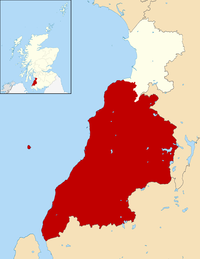
Clan Kennedy is a Scottish clan of the Scottish Lowlands.

Dunure Castle is located on the west coast of Scotland, in South Ayrshire, about five miles south of Ayr and close to the village of Dunure. Today the castle stands in ruins on a rocky promontory on the Carrick coast, overlooking the small harbour of Dunure.

The old Barony and castle of Corsehill lay within the feudal Baillerie of Cunninghame, near Stewarton, now East Ayrshire, Scotland.
John Kennedy, 5th Earl of Cassilis was a Scottish peer, the son of Gilbert Kennedy, 4th Earl of Cassilis and Margaret Lyon.

Busbie Castle was situated in what is now known as Knockentiber, a village in East Ayrshire, Parish of Kilmaurs, Scotland. Knockentiber is 2 miles (3.2 km) WNW of Kilmarnock and 1/2 mile NE of Crosshouse. The castle overlooked the Carmel Glen and its Burn, which runs into the River Irvine, a mile or so to the south, after passing through the old Busbie Mill.
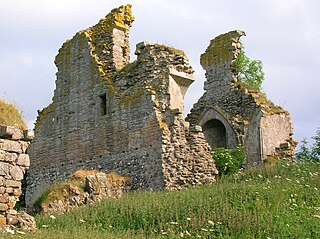
Craigie Castle, in the old Barony of Craigie, is a ruined fortification situated about 4 miles (6.4 km) southeast of Kilmarnock and 1 mile (1.6 km) southeast of Craigie village, in the Civil Parish of Craigie, South Ayrshire, Scotland. The castle is recognised as one of the earliest buildings in the county. It lies about 1.25 miles (2 km) west-south-west of Craigie church. Craigie Castle is protected as a scheduled monument.
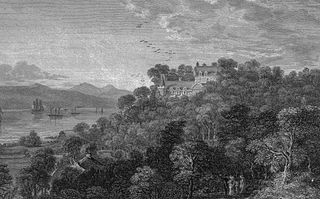
Skelmorlie Castle stands on the eastern shore of the Firth of Clyde, Scotland, at the north-western corner of the county of Ayrshire. The structure dates from 1502, and was formerly the seat and stronghold of the Montgomery Clan. The modern village of Skelmorlie lies to the north of the castle.
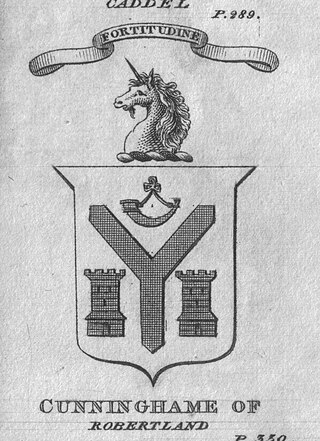
The Castle and Barony of Robertland is located near Stewarton, off the B769 road, in the old district of Cunninghame, Parish of Stewarton, and now part of East Ayrshire, Scotland.

Dunduff Castle is a restored stair-tower in South Ayrshire, Scotland, built on the hillside of Brown Carrick Hills above the Drumbane Burn, and overlooking the sea above the village of Dunure.

Fail Monastery, occasionally known as Failford Abbey, had a dedication to 'Saint Mary', and was located at Fail on the bank of the Water of Fail, Parish of Tarbolton near the town of Tarbolton, South Ayrshire. Most of the remaining monastery ruins were removed in 1952. The official and rarely used title was House of the Holy Trinity of Failford or the Ministry of Failford.

Terringzean Castle, also Taringzean, pronounced 'Tringan', is a Category B listed castle ruin lying above the River Lugar and the Terringzean Holm in the policies of Dumfries House, Parish of Cumnock, Scotland. The name Craufordstone or Craufurdstoun, has also been used, echoing that it and these lands originally belonged to the Crawfords, as did Lefnoreis Castle or Lochnorris Castle which once stood near the site of the Dumfries House stables.
Leswalt is a village and civil parish in Dumfries and Galloway, south-west Scotland. It lies between Portpatrick and Stranraer in the Rhins of Galloway, part of the traditional county of Wigtownshire. The parish covers around 8 square miles (21 km2).

Kerse Castle or Carse Castle is a ruined fortification once held by the Craufurd Clan, situated in the Parish of Dalrymple, East Ayrshire, Scotland.

The remains of the old castle of Montfode or Monfode lie to the north-west of the town of Ardrossan and 1.5 miles (2.4 km) south-west of West Kilbride in North Ayrshire, Scotland, above the Montfode Braes, in the old Barony of Kilbride. The remains of the 16th century tower are protected as a scheduled monument. The castle ruins are clearly visible from the A78 Ardrossan bypass.
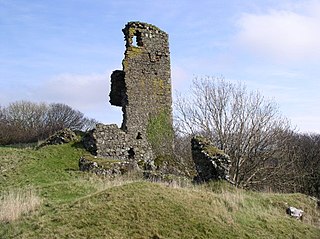
Ardstinchar Castle is a late medieval castle in the west coast of Ayrshire at the mouth of the River Stinchar. It was built by Hugh Kennedy of Ardstinchar in the mid-15th century. In the 1770s, the castle was demolished and the stone was used to build a bridge over the River Stinchar. Only remnants of the castle keep remain to this day. The site is a scheduled monument.

The ruins of the five storey high 15th century Carleton Castle lie in a prominent position above the village of Lendalfoot located on Carleton Bay, parish of Colmonell in the old district of Carrick, now South Ayrshire, about 6 miles south of Girvan, Scotland.
Gilbert Kennedy of Bargany and Ardstinchar was a Scottish landowner and murder victim. Kennedy had inherited a long-standing family feud with John Kennedy, 5th Earl of Cassilis, on the death of his father, Thomas Kennedy of Bargany. On 11 December 1601 he met the Earl and his followers at Pennyglen near Maybole and was murdered with a lance thrust in his back.
Thomas Kennedy of Bargany was a Scottish courtier and landowner.

Maybole Castle is a 16th-century castle located on High Street in Maybole, South Ayrshire, Scotland. Originally built for the Earls of Cassillis, it is an L-shaped construction with Victorian two-storey extensions. It is associated with a legend of John Faa, in which an earl killed Faa and imprisoned his wife, the Countess of Cassilis, in the castle.
Thomas Kennedy of Culzean was a Scottish landowner involved in a feud and a murder victim.


















